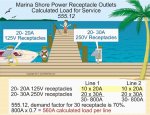The NEC is clear that if (2) receptacles with different voltages are provided in a pedestal, the receptacle with the higher kW demand should only be considered for load calculations. I just want to make sure though that if two receptacles with the same voltage (ie. 240v) are provided that both have to be used for load calculations.
Also, in the picture attached which is from Mike Holt's website, why do they use 30 receptacles instead of 40 because there are actually 40 receptacles total.
Also, in the picture attached which is from Mike Holt's website, why do they use 30 receptacles instead of 40 because there are actually 40 receptacles total.

